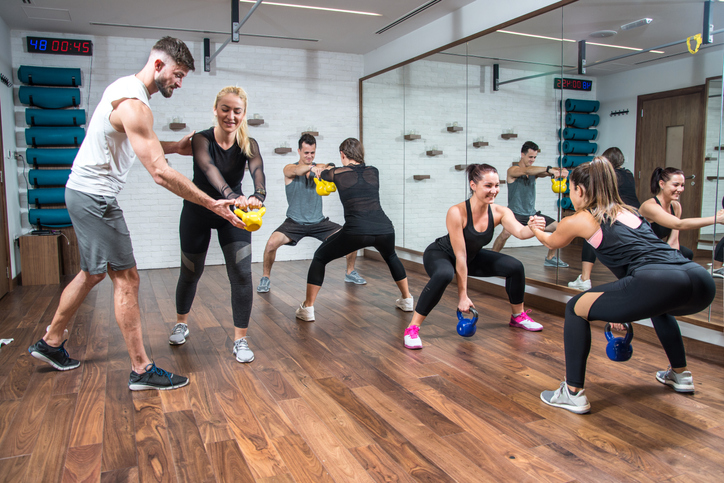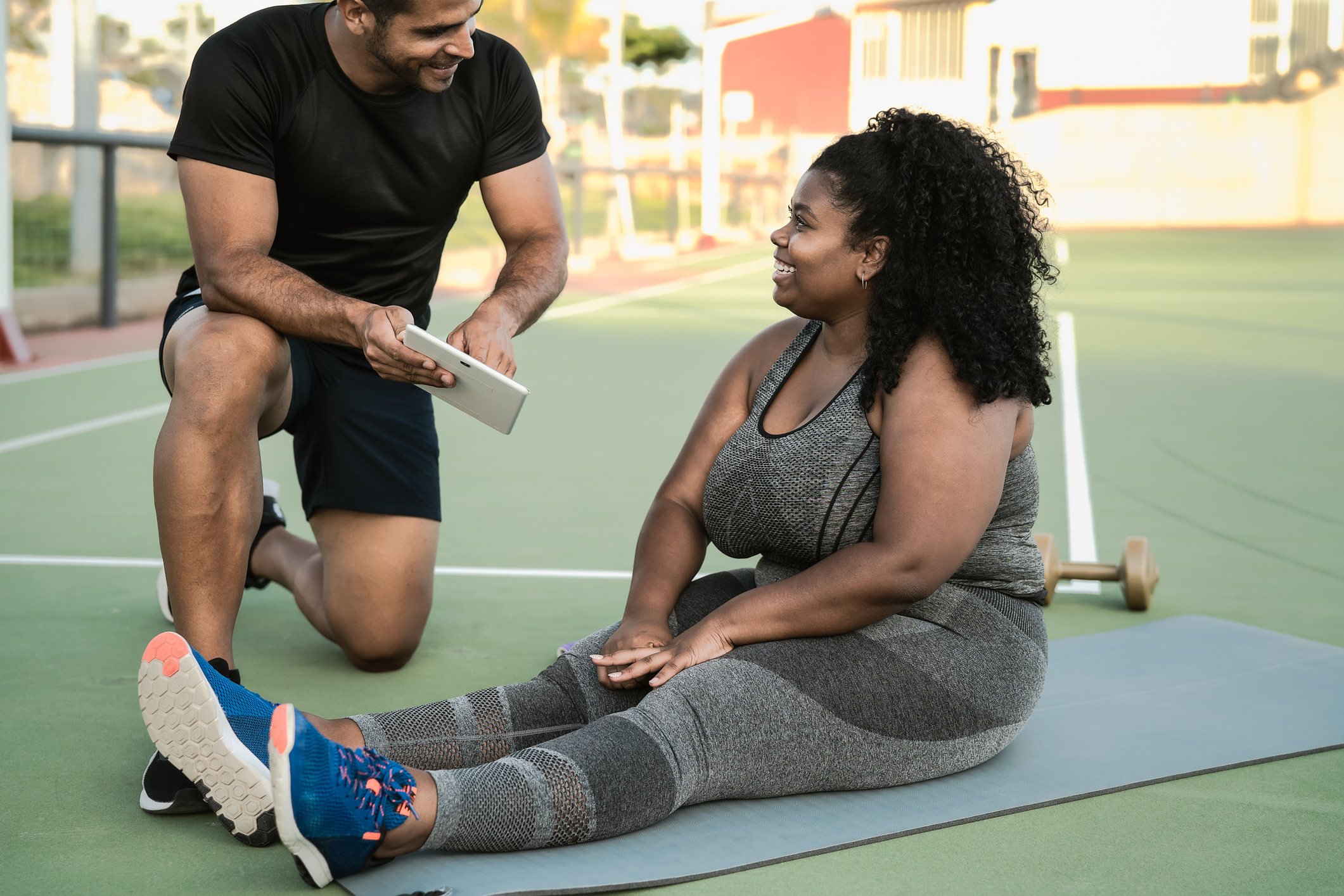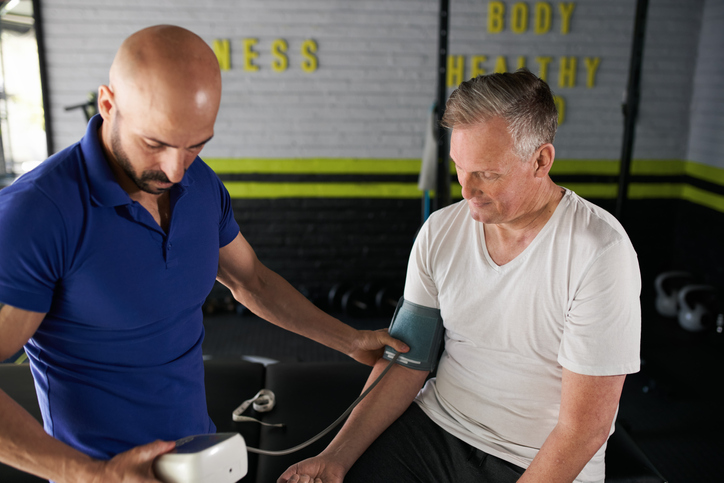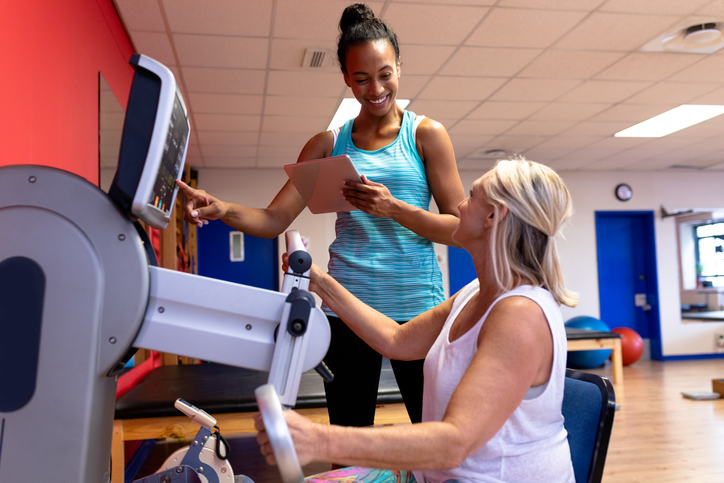Category: Fitness and Health
Communicating Effectively With Clients After Fitness and Health School
August 19, 2022If you’re pursuing a personal training career, you’ll be working very closely with clients. An effective personal trainer not only instructs and coaches their clients on fitness techniques but also fosters an open, trusting relationship with them. Your ability to do this will in large part determine the level of success you’ll be able to achieve in your personal training business.
Communication is an essential component of any business relationship but it goes beyond simply listening and talking. The context, in addition to the specific personality and preferences of your clients, should be taken into account as part of personalized communication. This way of interacting with clients makes them feel heard, understood, and safe which is essential when they choose to open up about something as personal as their health and fitness.
Maintaining client relationships through personalized communication is a skill that involves specific techniques. So how can you develop this ability for the success of your personal training career?
Practice Active Listening to Make Clients Feel Heard
As a personal trainer who has completed fitness and health training, you are an expert; however, it is essential that you keep your client relationships reciprocal and collaborative. This ensures that your clients feel comfortable approaching you with their fitness challenges so that you can help them reach their goals. Through active listening, you can gain deep insight into your client’s unique situation in order to understand how you can best serve them and build a productive rapport. It involves more than just waiting for your client to stop talking so you can instruct them.

One excellent tip for personal trainers is motivational interviewing. This involves exploring your client’s behavior through open-ended questions that allow the client to reach their own conclusions about what’s best for them. Using this communication model, you should resist the urge to over-correct, strive to understand your client’s motivations and empower the client.
Use Nonverbal Communication Constructively
During training sessions, your clients will be using a lot of nonverbal cues to communicate with you. Your ability to pick up on these cues and adjust your approach accordingly will help you to anticipate their needs and provide the right guidance.
You can use nonverbal cues to guide and encourage your clients too. For example, when your client is having a hard time getting through a set of exercises, an enthusiastic gesture might be all they need to push them through the exhaustion they’re feeling. During training sessions, stay attentive both to what your clients verbalize and what their body language is telling you.

Use Your Fitness and Health Training to Become a Motivating Force
Fitness is all about pushing through challenges and from time to time, we all need a little motivation. In fitness and health school, you’ll learn several motivational techniques you can use to help your clients stay on track. One very important motivator is positive energy. Simply put, people love being around others who can lift them up and give them a fun experience. By fine-tuning your tone of voice, body language, and your enthusiasm, you can ensure that clients look forward to each session with you. It can also be extremely motivating for clients to feel as though their fitness is a team effort between you and them. You can establish this team rapport by using words like ‘we’ and ‘us.’
Ready to start taking fitness and health courses?
Contact Medix College to learn more!
In Fitness and Health Training? How to Get Clients Moving This Summer
June 20, 2022As the summertime approaches, people are looking for a way to get back in shape after a sedentary winter. As someone preparing for a career in fitness and health, you may find yourself helping clients to find ways to workout, without it feeling like a chore. Summer is the perfect opportunity to get fit, with plenty of chances to partake in sports, games and other activities under the sun. For your clients who are hesitant to resume their fitness journey, there are a few ways you can help them to stay motivated. Below, discover five different summer activities you can introduce to your clients so they can keep moving this summer.
Have Your Clients Start Swimming After Fitness and Health School
Whether your clients are experienced or beginners, swimming is a great way to exercise in the summer. Especially for those who hate sweating, swimming is a great activity because your clients won’t feel the sweat on their skin while they’re in the water. As you may have learned about in fitness and health training, this activity comes with many other benefits, such as alleviating joint or knee pain. Swimming removes stress from the joints, as the buoyancy from the water supports a swimmer’s body weight. such as helping clients that have sensitive knee or joint pain. If your client suffers from knee sensitivity, suggest they swim frequently, as muscles will form around their knee to create more joint support.

Hiking with the Dog or Family and Friends
If your client enjoys spending time with family and friends as well as outside, you might suggest that they go hiking. Whether it’s flat trails or even a mountain, everyone will be able to enjoy each other’s company while getting a good workout in. They might even consider bringing a picnic to enjoy during the hike. Especially for clients with dogs, hiking is a great plan, killing two birds with one stone as both them and their dog have the chance to exercise.
Practice your Mobility with Paddle Boarding
Whether your client is flexible or not, mobility is important to work on. During fitness and health courses, you may have learned about mobility as the way joints move inside their socket. With improved mobility, your clients can move more freely, increase their blood flow, and reduce stiffness in their bodies. Paddle boarding is a great activity for improved mobility, allowing clients to gain core strength and balance while reducing back pain.
Enjoy the Beach While Participating in a Beach Volleyball Game
Is your client looking to partake in a bit of competition while exercising? Why not suggest they join a beach volleyball league or team, allowing them to release some competitive energy while staying active. Playing volleyball indoors versus on the beach can add a challenge since playing on the beach tends to be more physically demanding than its indoor counterpart. From playing beach volleyball, your client can expect to have leaner and stronger legs, as well as leaner arms and a stronger core.

Train your Mental Health with a Meditation or Yoga Practice
Physical fitness isn’t only about improving cardio or gaining muscle but also feeling better mentally. Meditation is a great mental exercise and addition to a balanced fitness program. It has been proven to reduce stress, helping clients to partake in activities they enjoy. When you feel good mentally, it’s easier to get motivated to work out, which is why introducing meditation may increase the likelihood that clients get moving this summer. Meditation is a great way to balance out the stress from physical activity on the body while reducing chronic pain, heart disease and high blood pressure.
Are you interested in attending the fitness and health school?
Contact Medix College today for more information!
Creating Effective Client Loyalty Programs After Fitness and Health School
April 22, 2022Loyalty programs are the bread and butter of many businesses–ensuring that customers return regularly and income remains stable. However, within the fitness industry, the value of loyalty programs takes on a new meaning. As a fitness professional, creating a loyalty program for your client base can not only improve the satisfaction of your current customers, but it can help to grow your fitness business. Increases in client retention can increase profits, opening up new possibilities and resulting in enhanced career success.
If you’re seeking a career in fitness and health, completing a training program at Medix College will successfully prepare you to train clients in accordance with their individual needs, helping them to achieve their goals. With your skills, you’ll be prepared to operate your own fitness business and develop member incentive programs, among a number of other capabilities.
Below, learn more about the creation of loyalty and membership incentive programs during your career in fitness and health.
Why Creating Loyalty Programs After Fitness and Health Training Is Important
As a fitness professional, loyalty programs are both valuable to your business and compatible with the nature of the work you do. As a fitness and health school grad, creating loyalty programs helps you to form beneficial relationships with your clients while keeping them motivated to push forward in their fitness journey. When your clients feel rewarded for remaining consistent in the process of getting in shape, they’ll not only be likely to keep using your services for a long period of time, but they’ll also probably tell their friends about their experience. Thus, the more you appeal to your clients with an effective loyalty program, the more successful your business will be. What’s more, you’ll be helping your clients to achieve their goals, fulfilling your mission as a fitness and health professional.

Incentivize Membership Renewal
Membership renewal is the biggest indicator of loyalty, and in order to encourage it, it’s important to invest in different ways to incentivize clients to renew. One way to ensure that your members renew is to implement an early renewal campaign. When members are approaching the end of their membership, these campaigns incentivize them by offering a discounted rate for a certain period of time, or create an installment renewal plan. Setting a time limit on these offers will give members a sense of urgency, making it more likely that they’ll take advantage of these programs.
Integrate Gifts and Rewards
A key component of any loyalty program is the integration of various rewards and gifts for returning clients. After fitness and health training, try identifying opportunities to incentivize your clients with gifts, credits or another type of reward. You might consider creating challenges for your clients, displaying their stats on a leaderboard with the possibility of winning a prize at the end of the competition. For example, a weekly leaderboard with a different challenge will keep your clients motivated, encouraging them to come back for more. The prize might be a discount on their monthly membership or a free set of resistance bands. You can also consider giving gifts to loyal clients on their birthdays or on holidays, or as a reward for achieving their weight or fitness goals. When your clients feel that their hard work is appreciated, they’re more likely to keep training with you.

Include a Referral System
Another great way to reward client loyalty is by establishing a referral program. Not only are referrals a great way to grow your business, but they can also be an opportunity to improve client retention. In order to create an effective referral program, you might consider crediting the accounts of clients with a discount when they refer a friend or family member, or offering them a free workout class. When your existing clients are inclined to spread the word about your business, you’ll see your success as a fitness professional improve.
Are you interested in fitness and health courses?
Enroll in a program with Medix College today!
4 Tips for Leading Group Exercise Courses After Fitness and Health Training
February 18, 2022As an aspiring fitness instructor, you’ll be eager to start your career and inspire others around you to pursue a healthy lifestyle. People will come to you for guidance and encouragement on how to work out, eat properly and reach their personal fitness goals. As a new health and fitness instructor, it’s important that you feel comfortable advising clients in various settings and through different programs–including in group exercise courses.
At Medix College, we provide you with hands-on training to help you become a highly qualified personal trainer and health coach. Our program informs your understanding of the anatomy and physiology of different body systems, exercise prescription, fitness assessment, nutrition and more. With the right knowledge and experience, you’ll be ready to lead group exercise courses from the get-go. Below, discover the four tips on leading group exercises!
1. Pay Attention to Individuals in Your Group After Fitness and Health Training
Leading group exercises is about more than just letting people follow your lead in a group setting. It is about paying attention to the safety of each and every one of your clients. This is particularly important in a group setting, where you have multiple clients to look out for.
Ensuring that there’s enough space between each client can help to avoid any accidents during exercise routines. At the same time, you should ensure that all clients know how to use the relevant workout equipment. As a qualified instructor with fitness and health training under your belt, you’ll have to monitor each client’s form to avoid any sort of injuries from occurring. By monitoring each client’s positioning while they’re using free weights and performing resistance exercises, you can prevent individuals in your group from placing excessive stress on their bodies.

2. Shake Things Up From Time to Time
Keeping a consistent routine with your exercise courses isn’t a bad thing, since you’ll ensure that your clients get to grips with the workout. However, consistency with little variation can often lead your clients to lose interest in attending your exercise classes if they don’t feel fully engaged. After fitness and health courses, take the time to shake things up during your exercise classes to help engage your clients and keep the momentum high in class. Look into focusing on various exercises or drills each day that keep the body pumping. For example, you can opt to focus one day on a kickboxing session, another on a bodyweight cardio session and another on a weight training session.
3. It’s Not a One-Size-Fits-All Approach
As a fitness instructor, you should invest time in understanding every client’s abilities and goals. Your clients may have similar goals in your group training sessions, but every individual is different in the way they learn or in the way they’re motivated. Your exercise routines and your methods of teaching shouldn’t follow a one-size-fits-all approach. Some of your clients may need you to provide them with that extra push to give it they’re all in training. Others may need to take things at a slower pace with more encouragement. Knowing your clients will allow you to tailor your approach to the individual and create a personalized experience in your group classes.

4. Build a Strong Connection With Your Clients
As a fitness instructor, it’s important to build strong connections with your clients. Clients will want your honest advice on their progress and your assurance that they’re on the right path. They may have concerns or questions regarding their exercise routine, their physical condition or their nutritional needs. Take the time after each group session to meet with individual clients and connect with them on a personal level. When you invest time and energy in understanding your clients, you’ll establish trust and build more productive relationships with them. With the right approach, they’ll be ready to place their confidence in you to lead them towards their fitness and health goals.
Interested in fitness and health school?
Contact Medix College to learn more!
Helping Your Clients Set Goals for the New Year After Fitness and Health School
December 30, 2021With the new year around the corner, many are looking to make the change towards a fit and healthy lifestyle and find the confidence that goes with it. Many have new year resolutions, but tend to fall short of achieving them without proper planning. Some individuals have the desire for change, but may lack the guidance to transform their desires into actionable goals.
At Medix College, our Health and Fitness Certificate program prepares you to educate and train your clients on their way to achieving their health and fitness goals in the long-term. As a fitness instructor, you’ll make a positive impact on those seeking change and become the motivating force they require to succeed. Read on to learn how you can help your clients set goals for the new year.
Set SMART Goals that are Attainable
By setting SMART goals, you’re setting clear guidelines for your clients to achieve their goals. They help put everything into perspective, giving clients the clarity and confidence they need to see their plans through. SMART stands for: Specific, Measurable, Achievable, Realistic, and Time-Oriented. At Medix College, you’ll learn how to guide and empower your clients as part of your fitness and health training. You’ll be able to develop specific goals based on your client’s capabilities and history while measuring their progress in terms of weight, fitness, and other variables.
Set Short and Long-Term Goals for Clients After Fitness and Health School
Attending a fitness and health school like Medix College will provide you with the hands-on experience you need to instruct clients in athletic activities and fitness techniques that will benefit both their short and long-term goals. By setting long-term health and fitness goals for your clients, you’re putting them on the right path for the future and giving them a structured plan to follow over the months or years to come. Long-term goals can be easily achieved by setting short-term goals along the way. Short-term goals act as stepping stones; they provide clients with more manageable steps to take as they work towards achieving their long-term goals.

Encourage Clients to Express their Thoughts After Each Workout
As a fitness instructor, it’s a good idea to encourage clients to record their thoughts after each daily exercise. By recording their daily workouts, clients have the opportunity to express themselves freely to you and discuss any challenges or successes they experienced.

This will give both you and the client a chance to monitor their progress and work through any concerns or issues they may have faced during their week of training. You can start doing this for their short-term goals and monitor their gradual progress as they continue towards the long-term goals. With the Fitness and Health program at Medix College, you’ll be on your way to rewarding career opportunities helping others across the fitness and health industry.
Ready to start fitness and health courses?
Contact Medix College to learn more about our Health and Fitness Certificate Program!
The Benefits of Completing an Externship After Fitness and Health Training
November 03, 2021If you’ve made the switch to a new career in fitness and health, it may be daunting to navigate the field as a new grad. Externships are a great way to kickstart your career and prepare you for any challenges you may face.
An externship is a short-term placement that provides hands-on learning experience for a given field. For fitness and health training, these often take place in a gym or fitness facility, and can be either paid or unpaid.
Ideally, your health and fitness program will offer externships as part of the curriculum just as ours does, placing students at facilities in the area with highly applicable programs. During your externship, you should expect to learn first-hand the details of the job from certified professionals in your new field.
Read on for a more detailed breakdown of the benefits of completing an externship.
Gain Invaluable Experience in Your Field Through an Externship Placement
You may have aced your exams and passed your certification with flying colours. However, your lessons can only prepare you so much for life outside of your program. It is necessary to take your skills learned in the classroom and apply them to real life situations in order to master your knowledge and abilities.
An externship offered alongside fitness and health training will help you develop your coaching style as you are able to participate in training sessions, consultations, and program development. Working alongside experienced fitness professionals allows you to find mentorship and guidance as you start out your career.
You’ll also get to experience different styles of training while gaining exposure to a variety of populations as you start to take on clients of all ages and experience levels. Externships provide a high level of support as you continue to experience new situations on the job, catering to an environment fostering the growth of the extern.

Increase Your Likelihood of Landing a Job After Fitness and Health School
Building your resume as a newly certified professional is challenging after a career change. One major benefit of an externship is the time spent in person at a training facility, which will probably have a similar setting as the jobs you’ll be applying for. Having this experience after graduating with your certificate from fitness and health school will ensure your resume stands out to employers.
Another reward for completing an externship is the relationships you build during your time spent on the floor with both coworkers and clients. You will be able to form extensive relationships with gym owners, other experienced trainers, and potential future clients. The connections you make during these hours can be extremely influential on your career, showcasing your professionalism and dedication to your work.

Boost Your Confidence in Your New Career
It’s important as a new fitness and health professional to find your voice as a leader in the field. Confidence is a key component for a successful career, and practicing your interactions with other professionals, clients, and prospects will prepare you for your new role.
The more you immerse yourself in an environment, the more comfortable you will feel. Externships let you get involved, give you the support you need to improve, and provide further education so you can feel like an expert in the health and fitness field. Putting to work the knowledge you acquired in your program along with the experience you gained in your externship will boost your confidence, preparing you to comfortably take on your own clients and responsibilities.
Are you interested in finding fitness and health courses that include an externship?
Contact Medix College for more information!
A Guide to Fitness Assessments for Those Considering Fitness and Health Training
September 24, 2021Fitness assessments are a useful tool for both trainers and clients in the fitness industry. A fitness assessment is carried out by a professional to obtain health and fitness information on a client. Trainers and clients can then develop an individual fitness plan that will build on that foundation.
Many fitness assessments test the numerous components of fitness, including cardiorespiratory endurance, muscular strength, flexibility, and body composition. With a comprehensive understanding of a client’s fitness levels, consultants can design exercise programs that are customized to an individual’s needs and goals. Through regular re-assessments, professionals can motivate clients, educate them on exercise and nutrition, and monitor progressions in their fitness journey. Read on to learn all you need to know about fitness assessments!
Why Are Fitness Assessments Important?
Measuring a client’s starting point and reviewing their progress is an important part of developing an effective fitness program. Fitness assessments can provide a wealth of information to help you understand your client’s strengths and weaknesses. Not only do they provide a foundation from which to plan a fitness program, but they also offer a way of comparing results over a period of time.
As those in fitness and health training know, exercise programs are about progress. Even if a client can’t see the results, a fitness assessment can reveal whether they’re on the right track. Trainers can use these results to increase client motivation and identify areas for further development. By highlighting areas of weakness, fitness assessments can also help professionals to plan a program that minimizes the risk of injury to their clients. As an informative resource, fitness assessments are a great way to build loyalty with clients and cultivate trust in your professional expertise.

The Components of a Good Fitness Assessment
A good fitness assessment should always begin with the client. First and foremost, professionals should identify their client’s individual goals and the areas they’re hoping to improve. There are a few key things to consider when creating a fitness assessment. When working with a new client, you’ll need to factor in their age, injury history, and the goals they want to achieve. Each of these factors will help you to tailor the assessment to get the right results with the health and safety of your client in mind.
With this information in mind, a fitness assessment should involve a series of exercises using five key elements: health evaluation, body composition tests, cardiovascular endurance tests, body strength tests, and joint flexibility tests. By delivering results in each area, a fitness assessment provides a baseline for new clients from which you can develop a clear and constructive exercise program.

Applying Your Fitness and Health Training
Students in fitness and health courses gain practical experience in fitness consultancy, where they’ll learn how to conduct fitness assessments and prescribe exercise programs based on the results. Graduates of this program will be ready to analyze a client’s needs, instruct them in fitness techniques, and monitor their progress. Fitness assessments provide a valuable point of reference for applying your training to new clients in commercial fitness facilities, recreational facilities, public health departments, and more. As society continues to emphasize the importance of personal health, trained professionals are a valuable resource with techniques to guide the field of fitness.
Looking to enroll in fitness and health school?
Start your training with a program at Medix College!
Taking Fitness and Health Courses? 3 Tips for Managing Your Business as a Personal Trainer
August 04, 2021
Personal trainers perform fitness assessments for clients to determine their abilities and design exercise programs that are tailored to their individual needs. A personal trainer is responsible for motivating their clients, educating them on exercise and nutrition, and monitoring their progress through regular assessments to help clients achieve their fitness goals.
As society becomes more and more concerned with fitness and health–including the benefits of regular exercise–the demand for personal trainers with knowledge and experience in this field will increase. Managing your own personal training business can be a rewarding and independent way to take charge of your career. However, ensuring the success of that business requires dedication, organization, and a solid business plan for marketing and adapting your skills to the client demand.
Let’s take a closer look at some of the top tips to bear in mind when managing your personal training business!
1. Identify Your Expertise After Fitness and Health School
If you’re just thinking about starting your personal trainer business after fitness and health school, there’s no need to consider a specialization just yet. It’s a good idea to apply your general training to come to terms with the basic tools and training styles. The right fitness and health program will teach students how to demonstrate and instruct different athletic activities and techniques. Over time, you’ll come to identify the specific areas in which you excel. When you reach the stage of managing your own business, take the time to recognize your own skillset and promote it consistently.
To compete in the wider industry, clients should be able to identify you as an expert in an area of fitness. In most cases, your client has a particular goal and wants to know that they are working with someone who has the relevant expertise. By positioning yourself as the go-to trainer in your specialty, you can distinguish yourself in the broad field of fitness businesses.

2. Stick to a Consistent Schedule
Managing any successful business requires a high degree of organization and planning. To structure your time efficiently, develop a solid schedule and stick to it. Your working hours should be consistent each week and clients should be clear on the allocated time they have. Prioritizing your time is important to running a profitable and efficient service that allows for your other personal or professional commitments. There are numerous facets to a business beyond the service itself. Know how much time you are dedicating to training sessions, and how much time you need for business marketing, recruitment, or other strategies. The right fitness and health program will cover the essentials of business management to ensure that you don’t sacrifice the operational side of your fitness and health career.

3. Always Listen to Client Feedback
Students in fitness and health training will acquire the skills to analyze and understand their clients’ needs and goals. The aim of your service is to help those clients achieve their goals. Client feedback is a valuable resource for evaluating and improving your business. You can understand which techniques work, which practices to avoid, and adapt your training program accordingly. Not to mention, client testimonials are a great way to build the reputation of your business. The success stories of your current clients will improve the credibility of your business and assist you in landing new clients. First and foremost, prospective clients want to know that your fitness program produces results. By prioritizing and showcasing the feedback of your clients, you can manage a successful business that caters to the growing demand for fitness expertise.
Are you interested in taking fitness and health courses?
Contact Medix College for more information on our program!
How Professionals with Fitness and Health Training Can Help Clients Prevent Injuries
June 25, 2021
If you’re seeking a career as a personal trainer or fitness coach, you’ll be helping your clients to reach their fitness goals by implementing training programs tailored to their personal needs. However, a training program is only as effective as the injury prevention methods it incorporates. As a personal trainer, keeping your clients healthy and able-bodied will be your main priority. In order to ensure that your clients can perform at their highest level and maintain their physical fitness for years to come, it’s important to ensure that your clients remain free of pain and steer clear of injuries–which could hinder their fitness journey.
Below, discover some injury prevention practices that you can incorporate into your training programs when working with clients.
Those with Fitness and Health Training Should Know to Never Skip the Warm Up
Beginning a training session with a warm-up is a crucial step when it comes to preventing injury. Warm-up exercises serve to promote blood flow throughout the body and to distribute energy to the muscles. After graduating from fitness and health school, it’s important to ensure that your clients warm up before a workout–as this practice prepares the muscles to articulate, extend, and contract. On the other hand, skipping the warm-up can put muscles at a greater risk of strain–increasing the likelihood of injury. Ideally, a warm-up should last around 15 minutes, consisting of a combination of mobility exercises, stretching, and light cardio.

Take Note of the Smaller Details
As a personal trainer, it’s easy to make the mistake of assigning your clients a workout and not paying close enough attention while they complete their reps. However tempting it may be to scroll through your phone during a long session, a key component of your ability to keep clients injury free is the close observation of their movements while they perform an exercise. Your undivided attention is essential when it comes to spotting problems with your clients’ posture, body signals, and pain reflexes. In order to prevent your clients from getting injured, it’s important to pay attention to the little details, correcting them when they’re performing an exercise incorrectly, or stopping them when you notice signs of overexertion.
Tailor the Exercise to Your Client
Each client that you work with will have different goals, different capabilities, and different levels of fitness. Those with fitness and health training will come to know the importance of tailoring each exercise program to a client’s personal needs in order to lower their risk of injury. Implementing a training program that doesn’t account for a client’s capacity for movement can lead to injury and overexertion, and can also negatively impact your client’s motivation. You can design a safe training program suited to your clients’ needs by substituting exercise modifications when necessary. For example, a client beginning their fitness journey may benefit from performing low-impact exercises rather than those involving jumping and other high-impact moves.

Avoid Pushing the Limit with Clients
While it can be tempting to plan an intense workout for your client in order to help them meet their goals–pushing your clients to their limit before they’re ready often results in injury. As a personal trainer, it’s important to focus on setting your clients up with a solid foundation before increasing their training volume. In any training program, there’s a point of diminished return, in which the limits of a client’s capacity are pushed to a point where their recovery time and risk of injury surpasses the physical benefits of the workout. During your career, help your clients to avoid injury by designing programs that build strength and endurance without imposing too many challenges or additional strain on their bodies. Developing a sustainable program for your clients will reduce their risk of injury and increase their training longevity in the long run.
Are you interested in taking fitness and health courses?
Get the training you need to become a personal trainer with a program at Medix College!
5 Ways Fitness and Health School Grads Help Clients Stay Motivated
April 23, 2021
Motivation is often one of the most significant obstacles for people when it comes to getting in shape or getting their health back on track. Individuals may lack confidence, or feel unsure about whether they’re able to put in the effort necessary to reach their goals. If you’re seeking a career in fitness and health, you’ll be helping clients to exercise and improve their nutrition with a program that works best for them. An important part of your job will be motivating clients to stay consistent and work to attain a higher level of health.
For those wondering how to keep clients on track with reaching their health goals, read on to discover five different techniques for boosting motivation.
1. After Fitness and Health Training, Start by Discovering Your Client’s “Why”
The first place to start when it comes to enhancing a client’s motivation is to determine their “why.” A client’s “why” is the reason that they have decided to embark on an exercise and nutrition journey. It may be that they’re training for an event, they want to improve their overall health, or they’re just looking for a new hobby. Whatever the reason, professionals with fitness and health training should have a conversation with their client to figure out their initial source of motivation. Knowing a client’s “why” will make it easier to develop a program that aligns with their general goals, enabling them to feel that they are making progress in a direction that’s important to them.
2. Work with Your Client to Set Realistic Goals
Goals are a key component of increasing motivation in the realm of fitness and health. Setting goals gives clients a metric by which they can judge their progress and keeps them engaged in the process of achieving their goal. However, it’s important to set goals that are both realistic and attainable. If your client has particularly high expectations for themselves, it may be beneficial to nudge them toward a goal which is more appropriate. Setting goals that can’t be achieved can actually decrease a client’s motivation, as they may be discouraged when their hard work isn’t paying off.

3. Find Workouts that Your Client Enjoys
It’s hard to stay motivated when we don’t enjoy what we’re doing, and the same philosophy applies to fitness and health. When working with clients, it’s important to pay attention to their preferences in terms of workouts and eating habits. Check in with clients throughout sessions to see how they’re feeling. If something isn’t working, don’t hesitate to make the switch to an activity they’ll enjoy more. While exercise isn’t necessarily easy, that doesn’t mean it shouldn’t be fun. By catering programs to client’s needs, fitness and health school graduates can ensure that their clients stay motivated to continue.

4. Educate Your Client on the Benefits of their Training
It can be difficult for clients to maintain their motivation when they don’t fully understand why or how the regimen they’re following is helping them. Fitness and health instructors can overcome this potential obstacle by keeping clients informed and involved in their training plan. Explain to clients the importance of a stretch, or tell them which muscle groups a workout is targeting. When clients understand the benefits of the work they’re putting in, they’re more likely to follow through and adhere to their fitness and health plan.
5. Hold Your Client Accountable
Let’s face it – it’s way easier to keep putting in work when you know that there’s someone who expects you to actually do the work. In order to keep your clients motivated, hold them accountable throughout their program. Regular check-ins, “homework” assignments (such as training logs), and setting timelines are all great ways to ensure that a client remains motivated outside of their sessions. When your client knows that they’re responsible for committing to their personal health and fitness, they’ll be more likely to remain motivated to become the best versions of themselves.
Are you interested in helping clients achieve their health and fitness goals?
Be sure to check out Medix College’s fitness and health courses today!











